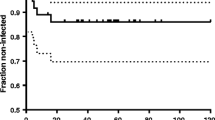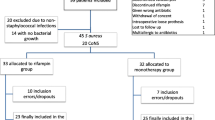Abstract
Purpose
Rifampin combination therapy plays an important role in the management of staphylococcal periprosthetic joint infection (PJI). However, the emergence of rifampin resistance is a feared complication. We retrospectively analysed predetermined potential risk factors in patients with rifampin-resistant staphylococcal PJI in a multicentre case–control study.
Methods
Cases (n = 48) were defined as PJI caused by rifampin-resistant staphylococci. Rifampin-susceptible controls (n = 48) were matched for microorganism and type of prosthetic joint. Uni- and multivariable conditional logistic regression analyses were performed to estimate odds ratios (OR) with 95 % confidence intervals (95 % CI).
Results
Forty-eight cases (31 men; median age 67 years; age range 39–88 years) with hip- (n = 29), knee- (n = 13), elbow- (n = 4), shoulder- (n = 1) or ankle-PJI (n = 1) were enrolled in the study. Staphylococcus aureus and coagulase-negative staphylococci were isolated in ten and 38 episodes, respectively. Most of the cases (n = 44, 92 %) had a previous PJI, and 93 % (n = 41) of these had been treated with rifampin. There was an independent association of emergence of rifampin resistance with male sex (OR 3.6, 95 % CI 1.2–11), ≥3 previous surgical revisions (OR 4.7, 95 % CI 1.6–14.2), PJI treatment with high initial bacterial load (inadequate surgical debridement, <2 weeks of intravenous treatment of the combination medication; OR 4.9, 95 % CI 1.6–15) and inadequate rifampin therapy (OR 5.4, 95 % CI 1.2–25).
Conclusions
Based on our results, extensive surgical debridement and adequate antibiotic therapy are needed to prevent the emergence of rifampin resistance.
Similar content being viewed by others
References
Drancourt M, Stein A, Argenson JN, Roiron R, Groulier P, Raoult D. Oral treatment of Staphylococcus spp. infected orthopaedic implants with fusidic acid or ofloxacin in combination with rifampicin. J Antimicrob Chemother. 1997;39:235–40.
Zimmerli W, Trampuz A, Ochsner PE. Prosthetic-joint infections. N Engl J Med. 2004;351:1645–54.
El Helou OC, Berbari EF, Lahr BD, et al. Efficacy and safety of rifampin containing regimen for staphylococcal prosthetic joint infections treated with debridement and retention. Eur J Clin Microbiol Infect Dis. 2010;29:961–7.
Barberan J, Aguilar L, Gimenez MJ, Carroquino G, Granizo JJ, Prieto J. Levofloxacin plus rifampicin conservative treatment of 25 early staphylococcal infections of osteosynthetic devices for rigid internal fixation. Int J Antimicrob Agents. 2008;32:154–7.
Berdal JE, Skramm I, Mowinckel P, Gulbrandsen P, Bjornholt JV. Use of rifampicin and ciprofloxacin combination therapy after surgical debridement in the treatment of early manifestation prosthetic joint infections. Clin Microbiol Infect. 2005;11:843–5.
Garrigos C, Murillo O, Euba G, et al. Efficacy of tigecycline alone and with rifampin in foreign-body infection by methicillin-resistant Staphylococcus aureus. J Infect. 2011;63:229–35.
Senneville E, Lombart A, Beltrand E, et al. Outcome of diabetic foot osteomyelitis treated nonsurgically: a retrospective cohort study. Diabetes Care. 2008;31:637–42.
Zimmerli W, Ochsner PE. Management of infection associated with prosthetic joints. Infection. 2003;31:99–108.
Mallet M, Loiez C, Melliez H, Yazdanpanah Y, Senneville E, Lemaire X. Staphylococcus simulans as an authentic pathogenic agent of osteoarticular infections. Infection. 2011;39:473–6.
Zimmerli W, Moser C. Pathogenesis and treatment concepts of orthopaedic biofilm infections. FEMS Immunol Med Microbiol. 2012;65:158–68.
Baldoni D, Hermann H, Frei R, Trampuz A, Steinhuber A. Performance of microcalorimetry for early detection of methicillin resistance in clinical isolates of Staphylococcus aureus. J Clin Microbiol. 2009;47:774–6.
John AK, Baldoni D, Haschke M, et al. Efficacy of daptomycin in implant-associated infection due to methicillin-resistant Staphylococcus aureus: importance of combination with rifampin. Antimicrob Agents Chemother. 2009;53:2719–24.
Trampuz A, Murphy CK, Rothstein DM, Widmer AF, Landmann R, Zimmerli W. Efficacy of a novel rifamycin derivative, ABI-0043, against Staphylococcus aureus in an experimental model of foreign-body infection. Antimicrob Agents Chemother. 2007;51:2540–5.
Baldoni D, Haschke M, Rajacic Z, Zimmerli W, Trampuz A. Linezolid alone or combined with rifampin against methicillin-resistant Staphylococcus aureus in experimental foreign-body infection. Antimicrob Agents Chemother. 2009;53:1142–8.
Saleh-Mghir A, Muller-Serieys C, Dinh A, Massias L, Cremieux AC. Adjunctive rifampin is crucial to optimizing daptomycin efficacy against rabbit prosthetic joint infection due to methicillin-resistant Staphylococcus aureus. Antimicrob Agents Chemother. 2011;55:4589–93.
Senneville E, Joulie D, Legout L, et al. Outcome and predictors of treatment failure in total hip/knee prosthetic joint infections due to Staphylococcus aureus. Clin Infect Dis. 2011;53:334–40.
Widmer AF, Gaechter A, Ochsner PE, Zimmerli W. Antimicrobial treatment of orthopedic implant-related infections with rifampin combinations. Clin Infect Dis. 1992;14:1251–3.
Stengel D, Bauwens K, Sehouli J, Ekkernkamp A, Porzsolt F. Systematic review and meta-analysis of antibiotic therapy for bone and joint infections. Lancet Infect Dis. 2001;1:175–88.
Zimmerli W, Widmer AF, Blatter M, Frei R, Ochsner PE. Role of rifampin for treatment of orthopedic implant-related staphylococcal infections: a randomized controlled trial. Foreign-Body Infection (FBI) Study Group. JAMA. 1998;20(279):1537–41.
Wehrli W. Rifampin: mechanisms of action and resistance. Rev Infect Dis. 1983;5[Suppl 3]:S407–11.
Liu Y, Cui J, Wang R, Wang X, Drlica K, Zhao X. Selection of rifampicin-resistant Staphylococcus aureus during tuberculosis therapy: concurrent bacterial eradication and acquisition of resistance. J Antimicrob Chemother. 2005;56:1172–5.
Sande MA, Mandell GL. Effect of rifampin on nasal carriage of Staphylococcus aureus. Antimicrob Agents Chemother. 1975;7:294–7.
Dunne WM Jr, Mason EO Jr, Kaplan SL. Diffusion of rifampin and vancomycin through a Staphylococcus epidermidis biofilm. Antimicrob Agents Chemother. 1993;37:2522–6.
Zavasky DM, Sande MA. Reconsideration of rifampin: a unique drug for a unique infection. JAMA. 1998;279:1575–7.
Trampuz A, Hanssen AD, Osmon DR, Mandrekar J, Steckelberg JM, Patel R. Synovial fluid leukocyte count and differential for the diagnosis of prosthetic knee infection. Am J Med. 2004;117:556–62.
Parvizi J, Jacovides C, Zmistowski B, Jung KA. Definition of periprosthetic joint infection: is there a consensus? Clin Orthop Relat Res. 2011;469:3022–30.
Ghanem E, Parvizi J, Burnett RS, et al. Cell count and differential of aspirated fluid in the diagnosis of infection at the site of total knee arthroplasty. J Bone Joint Surg Am. 2008;90:1637–43.
Trampuz A, Osmon DR, Hanssen AD, Steckelberg JM, Patel R. Molecular and antibiofilm approaches to prosthetic joint infection. Clin Orthop Relat Res. 2003;414:69–88.
Villar M, Marimon JM, Garcia-Arenzana JM, de la Campa AG, Ferrandiz MJ, Perez-Trallero E. Epidemiological and molecular aspects of rifampicin-resistant Staphylococcus aureus isolated from wounds, blood and respiratory samples. J Antimicrob Chemother. 2011;66:997–1000.
Murillo O, Garrigos C, Pachon ME, et al. Efficacy of high doses of daptomycin versus alternative therapies against experimental foreign-body infection by methicillin-resistant Staphylococcus aureus. Antimicrob Agents Chemother. 2009;53:4252–7.
Hellmark B, Soderquist B, Unemo M. Simultaneous species identification and detection of rifampicin resistance in staphylococci by sequencing of the rpoB gene. Eur J Clin Microbiol Infect Dis. 2009;28:183–90.
Tan CK, Lai CC, Liao CH, Lin SH, Huang YT, Hsueh PR. Increased rifampicin resistance in blood isolates of methicillin-resistant Staphylococcus aureus (MRSA) amongst patients exposed to rifampicin-containing antituberculous treatment. Int J Antimicrob Agents. 2011;37:550–3.
Didier JP, Villet R, Huggler E, et al. Impact of ciprofloxacin exposure on Staphylococcus aureus genomic alterations linked with emergence of rifampin resistance. Antimicrob Agents Chemother. 2011;55:1946–52.
Acknowledgements
We acknowledge the teams of the Division of Infectious Diseases and the Service of Orthopedic Surgery of the CHUV/Lausanne Switzerland for providing data of 2 patients in this study. This work was supported by an unrestricted grant of the Hans-Paul Wälchli Foundation for Research (Lugano, Switzerland).
Conflict of interest
None.
Author information
Authors and Affiliations
Corresponding author
Rights and permissions
About this article
Cite this article
Achermann, Y., Eigenmann, K., Ledergerber, B. et al. Factors associated with rifampin resistance in staphylococcal periprosthetic joint infections (PJI): a matched case–control study. Infection 41, 431–437 (2013). https://doi.org/10.1007/s15010-012-0325-7
Received:
Accepted:
Published:
Issue Date:
DOI: https://doi.org/10.1007/s15010-012-0325-7




